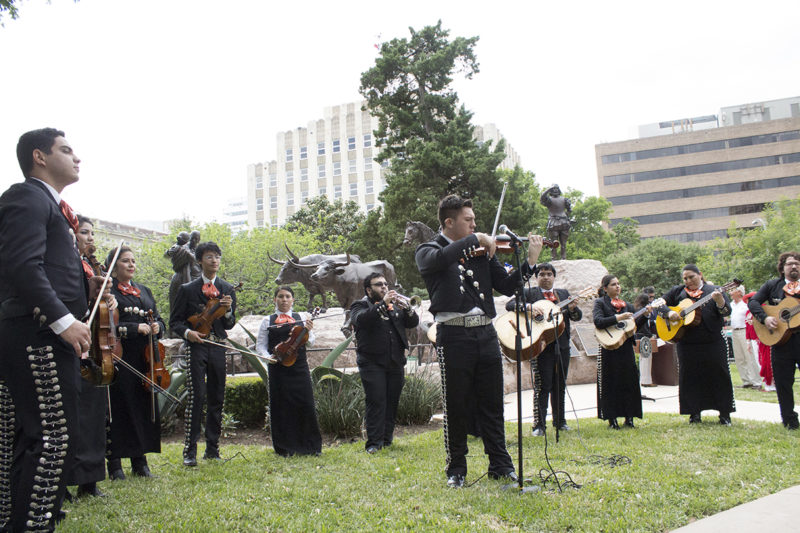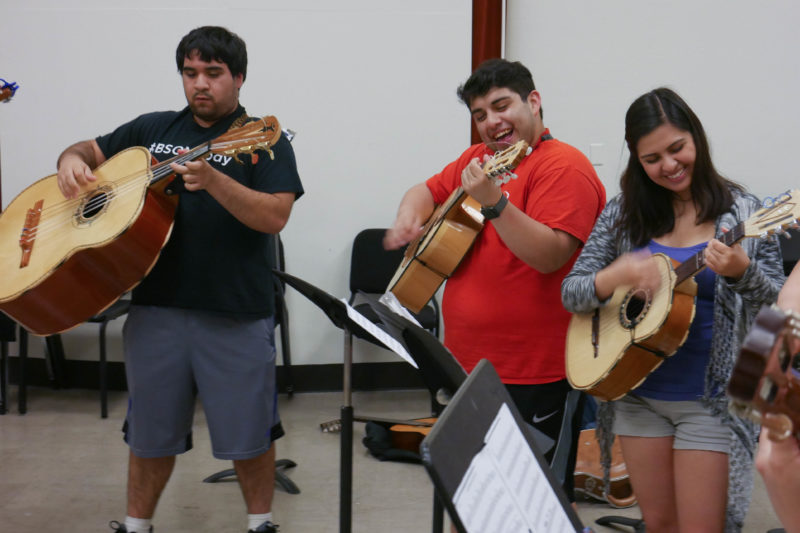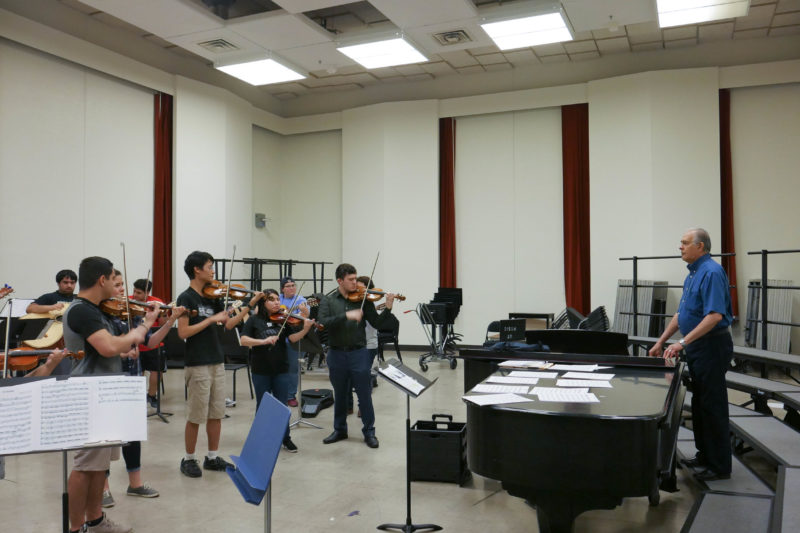Mariachi Summer Camp Preserves Tradition, But Future Is Uncertain
By César E. López Linares
Reporting Texas

Most of the members of UT’s mariachi ensemble are from South Texas. But a summer camp program that attracts high schoolers from that region is struggling. Cesar Lopez Linares/Reporting Texas
Marla Gutiérrez couldn’t believe her ears when her father told her that she would go to a summer camp. And it wouldn’t be the typical week of kayaking, bonfires and nature hikes.
Gutiérrez, 18, a high school student in Zapata and granddaughter of Mexican immigrants, attended the Longhorn Mariachi Summer Camp in 2015. On the University of Texas campus, she strengthened the music skills that she started developing at age 4 while reinforcing her heritage.
“I grew up listening to mariachi music. My grandma would play every Lucha Villa and Rocío Dúrcal song every time that I went to her house,” said Gutiérrez, now the lead trumpeter and vocalist of her high school mariachi band, the Zapata High School Mariachi Halcon.
The chance for more young students interested in mariachi to have the same experience is at risk, however. Most of the camp participants come from low-income families in South Texas. As a result, the program relies on donations to provide scholarships to help cover the $300 tuition for each camper. This year, both donations and enrollment are down.
A private donation allowed Gutiérrez and more than 15 members of the Zapata High School mariachi group to attend the camp, which is the least expensive of the summer programs UT-Austin’s Butler School of Music offers. It is also the one that struggles the most to enroll students.
The price, reduced this year from $360, is a big expense for families in South Texas, where the median annual income of Latino households is $33,000, according to the U.S. Census Bureau. South Texas covers San Antonio, Rio Grande Valley towns, and everything in between. Zapata is about four miles from the Mexico border.
“The school districts down on the border are getting by just to have enough books and pencils and stuff for the students,” said Zeke Castro, director of the UT mariachi ensemble and the camp’s organizer. “How many parents are there in South Texas that can just go and write a check for $300 to enroll their child?”
The program is aimed at students in grades nine, 10 and 11. It includes four days of instruction with musicians and mariachi directors from all around Texas, along with meals and housing at UT’s Jester Residence Hall. There is also a $200 option without housing for local campers.
Other summer camps at the Butler School, such as band, orchestra, choir, jazz and harp, sell out during the first days of registration, even though their prices range from $450 to $650. But aspiring mariachi campers must secure financial sponsorship before they can sign up.
Castro does fundraising activities to pay for uniforms and supplies, and the Butler School works with school districts and community partners to sponsor as many campers as possible.
“The other camps don’t receive support from the community,” said Ryan Kelly, director of the Longhorn Music Camps. “We have some donors that contribute with scholarships, but not this sort of community support that we actively sought with the mariachi program.”

Guitarists share a quick laugh after another student gave a ‘grito mexicano’ yell. The sound can be commonly heard at celebrations and parties but also carries patriotic conotations. Bri Mitchell/Reporting Texas
The most popular summer camps are the band and orchestra programs, which have been running for more than three decades. They receive up to 400 students every year.
By contrast, the mariachi camp attendance has fluctuated since it started five years ago. In 2016, 73 students participated. This year, fewer than 10 have signed up .
Still, the organizers are optimistic that they will surpass last year’s attendance. Interest in mariachi music doesn’t seem to be decreasing in parts of the state. More than 100 public middle and high schools in regions close to the border offer mariachi programs, according to the Texas Association of Mariachi Educators.
The areas from San Antonio to the Mexican border are hotbeds of mariachi music in public schools, Castro said.
“Public schools down there may not have a choir or orchestra, but they have a mariachi band. It’s a must, a political requirement. That is what people want their children to study,” he said.
Last year, the University Interscholastic League (UIL), which oversees athletic, music and academic competitions for public schools in Texas, included mariachi for the first time.
“We are keeping an eye right on the increased presence and importance of mariachi across the state,” Kelly said. “We are seeing that as an opportunity to increase recognition of mariachi as an important part of Texas music culture, so we are hoping that the mariachi camp at UT would provide additional opportunities for programs that are interested in that to flourish, to make their students to come here to study.”
Renato Ramírez, chairman of the board for the International Bank of Commerce in Zapata, is considered “the godfather of mariachi.” He earned the nickname after contributing at least $15,000 every year to sponsor students from cities like Laredo, Zapata, Roma and Rio Grande to attend the Longhorn summer camp. He also donates regularly to the UT Mariachi Ensemble.
Ramírez believes that young students in his community have the strongest talents for mariachi in all of Texas. That is why he is interested in helping them improve their musical abilities while also exposing them to the state’s flagship university in Austin.
“We have [a lot of] local talent, but they can’t afford to go to UT, so they are going to UT Rio Grande Valley, or to Texas A&M, or to Laredo Community College,” Ramírez said. “All of those schools have excellent mariachi bands, and it’s cheaper to go there. But if the students get a degree in local institutions, they are limiting themselves to stay working in South Texas. If they go to UT Austin, they are opening doors in a bigger scale.”

The violin sextet lines up to play during a practice session. Bri Mitchell/Reporting Texas
The Zapata High School Mariachi Halcon triumphed at the second UIL State Mariachi Festival in March — success the young musicians attribute, in part, to what they learned at the Longhorn camp.
“We wanted to prove that what we did in that camp would be put to good use,” Gutiérrez said. “And this year we got first division, which is state champions, at UIL Mariachi Festival, and it was because of the UT Longhorn Mariachi camp, which made the whole group extremely strong.”
Gutiérrez said that more people and institutions in the community with the means to help students financially should consider the benefits beyond music. The camp helps inspire students and connect them with their Mexican roots, she said.
“You have to have guts to play this type of music,” Gutiérrez said. “You have to be vulnerable and allow your own emotion take over the song. You have to put your essence in the music in order to produce the sound, the quality at a very high caliber, and only mariachi can do that for you. Once you become a part of mariachi, it becomes your life.”